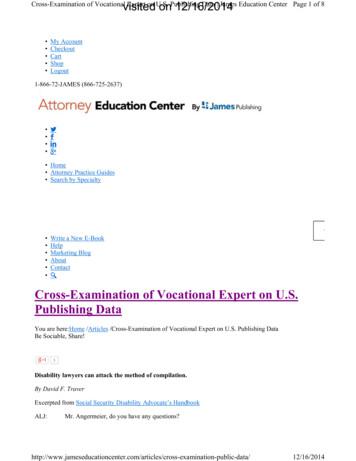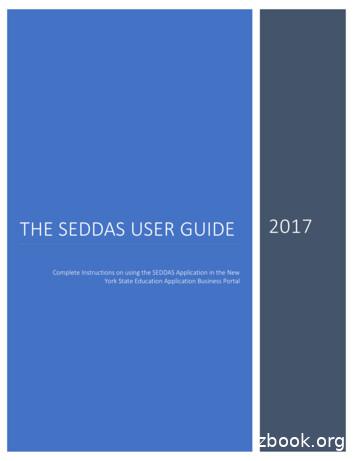Cross-section Overview Cross-Section Instructions Sample .
Stream Habitat Measurement TechniquesCross-SectionCross-section OverviewCross-Section InstructionsSample Cross-section Survey NotesCross-section Survey FormsDay 2: Stream Survey
Day 2: Field DayStream Habitat Measurement TechniquesCross-Section LocationsAppropriate locations to measure bankfull widths corresponding to a consistent normal highflow (bankfull) stage are indicated for riffle/pool and step/pool channels in Figure A-5.Riffle / Pool SYSTEMFLOWPoint BarFLOWCross-SectionsCutbank / Outside Turn AreaStep / Pool SYSTEMPLAN VIEWCROSS-SECTION VIEWS1POOL2STEP3RUN4POOLThe location of cross-section 3is recommended for “bankfull”measurements.1234PROFILE VIEWFigure A-5. Recommended cross-section locations for bankfull cross-sectional area measurements.1Copyright 2013 Wildland Hydrology
Stream Habitat Measurement TechniquesDay 2: Field DayFigure A-6. Typical channel features for a C Stream Type in a terraced, alluvial Valley Type VIII.Figure A-7. Bankfull width and Cross-sectional area obtained from the riffle cross-section.Figure A-8. Bankfull mean depth and bankfull maximum depth obtained from the riffle cross-section.Copyright 2013 Wildland Hydrology2
Day 2: Field DayStream Habitat Measurement TechniquesSTEPS:1. Obtain a ROD READING for an Elevation at the “MAX DEPTH” Location.2. Obtain a ROD READING for an Elevation at the “BANKFULL STAGE” Location.3. Subtract the “Step 2” reading from the “Step 1” reading to obtain a “MAX DEPTH” value.Multiply the “MAX DEPTH” value by 2 for the “2 x MAX DEPTH” value.SURVEYOR’S ROD4. Subtract the “2 x MAX DEPTH” value from the “Step 1 Rod Reading” for theFLOOD-PRONE AREA Location Rod Reading. Move the rod upslope, online withthe cross-section until a Rod Reading for the Flood-Prone Area Location is obtained.442SURVEYOR’S LEVEL1FLOOD-PRONE AREABANKFULL STAGE6Elevation / Width 52 x MAX DEPTHMAX DEPTH5. Mark the Flood-Prone Area (FPA) locations on each bank. Measure the DISTANCE between the two “FPA” locations.6. Determine the DISTANCE between the two BANKFULL Stage locations.7. Divide the FPA WIDTH by the BANKFULL WIDTH tocalculate the ENTRENCHMENT RATIO.Figure A-9. Determining Entrenchment Ratio.Figure A-10. Determining Width of the Flood-Prone Area (Wfpa).3Copyright 2013 Wildland Hydrology
Day 2: Field DayStream Habitat Measurement TechniquesCross-Section Instructions1.Setup the surveying instrument in a location where the entire cross-section can be viewed. Theinstrument should be placed at an elevation higher than the highest feature required for the survey.Ideally, only one instrument setup will be required to survey the entire cross-section; however,determining the width of the flood-prone area may require multiple instrument setups due to densefoliage.2. Stretch the tape across the channel (zero on left bank) making sure the tape is perpendicular to thebankfull discharge flow – not the baseflow.3. Backsight (BS) a benchmark or permanent feature used for relocation or resurvey of cross-section.4. Calculate Height of Instrument (HI); HI BS Elevation (known or relative).5. Obtain rod readings (Fore-Sights) at major breaks in bed elevation and key features, such as left bankfull(LBKF), left edge water (LEW), Thalweg (THL), right edge water (REW) and right bankfull (RBKF).6. Record the distance on the stationing tape, the corresponding rod height and feature notes in thecross-section forms (see Table A-2 for example).7. Measure the flood-prone area width (width of the channel at an elevation that is two times the maximumbankfull depth) (Figure A-10) ‒ be sure to measure perpendicular to the fall line of the valley.8. Plot cross-section; calculate the bankfull cross-sectional area and bankfull width (Figure A-11, Table A-3).9. Calculate bankfull mean depth, width/depth ratio and entrenchment ratio (Table A-4).10. Using the appropriate regional curves, check to make sure the cross-sectional area, bankfull width anddepth are reasonable. Make sure the bankfull velocity is reasonable (velocity bankfull discharge/bankfull area).11. Record all data in the appropriate forms (Worksheet A-1 and Worksheet A-3).Table A-2. Form to record cross-section notes with example data.SURVEY DATACROSSSITE: Lower Nevada Creek nr Helmville, MT- SECTION1Date: 8/8/06Location: nr USGS Gauge # 12335500200002HUC: 10Party / Notes: Team #4Distance,Height ofPoint, or Back-Sight Instrument pyright 2013 Wildland Hydrology4
Day 2: Field DayStream Habitat Measurement TechniquesCROSS - SECTIONSURVEY DATASITE:Date:Location:Party / Notes:HUC:Distance,Height ofPoint, or Back-Sight Instrument 22232425262728Copyright 2013 Wildland Hydrology5
Day 2: Field DayStream Habitat Measurement TechniquesCROSS - SECTIONSURVEY REMARKSNOTES 5051525354555657585962Copyright 2013 Wildland Hydrology
8. Plot cross-section; calculate the bankfull cross-sectional area and bankfull width (Figure A-11, Table A-3). 9. Calculate bankfull mean depth, width/depth ratio and entrenchment ratio (Table A-4). 10. Using the appropriate regional curves, check to make sure the cross-sectional area, bankfull width and depth are reasonable.
Cross Examination in Drunk Driving Cases Cross Examining Experts in New York Cross-Examination of Eyewitnesses Cross-Examination of Vocational Expert on Census Data Cross-Examination of Vocational Expert on U.S. Publishing Data Cross-Examination Strategies Cross-Examining the Defense Doctor re Pain
Overview of Cross-Border Payments 4 Scale of cross-border payments and international trade 4 How cross-border payments work today 5 Example of cross-border payment flow 6 Cross-Border Payment Challenges 8 1. Domestic infrastructures are not designed to handle cross-border payments 8 2. Lack of common message standards 9 3.
3 TABLE OF CONTENTS 1. EXO Platform Overview 1.1 EXO1 Sonde Overview 1.2 EXO2 Sonde Overview 1.3 EXO2S Sonde Overview 1.4 EXO3 Sonde Overview 1.5 EXO Field Cables Overview 1.6 EXO Handheld Overview 1.7 EXO GO Overview 2. Operation 2.1 Sonde Install / Replace EXO1 Batteries 2.2 Sonde Install / Replace EXO2 and EXO3 Batteries 2.3 Install / Remove Guard or Cal. Cup 2.4
3. Cross section . C–C’ from the Heart Mountain gas field to Emblem gas field .link 4. Cross section . D–D’ from the Oregon Basin anticline to Greybull .link 5. Cross section . E–E’ from the Grass Creek anticline to the Five Mile trend.link 6. Cross section . F–F’ from Montana to the southeastern margin of the .
Types of cross stitch Cross stitches are created on a matrix of squares or ‘pixels’. Any part of the square can be stitched, from the edges to the diagonals. The full range of cross stitches is listed below. Cross stitch fills When using cross stitch as a fill you can select from any of the cross stitch fill types. Full cross stitch
James Patterson Reading List 1 Alex Cross Books 1. Along Came A Spider 2. Kiss the Girls 3. Jack & Jill 4. Cat & Mouse 5. Pop Goes the Weasel 6. Roses Are Red 7. Violets Are Blue 8. Four Blind Mice 9. The Big Bad Wolf 10. London Bridges 11. Mary, Mary 12. Cross 13. Double Cross 14. Cross Country 15. I, Alex Cross 16. Cross Fire 17. Kill Alex .
THE SEDDAS USER GUIDE . Index. Section 1: Overview Section 2: Search for User Section 3: Create User ID Section 4: Reassign Institution Section 5: Advanced Search Section 6: Update User Section 7: Disable User ID. Section 8: Reactivate User ID Section 9: Reset Password and Unlock Account Section 10: Entitlements-Overview
adventure tourism (ISO 21101 and TR 21102)2 addresses adventure travel specifically, and none of these standards or quality assurance systems cover all the aspects necessary for excellent adventure travel guiding. In the absence of a global qualification and performance standard, a variety of approaches to managing adventure travel guiding can be























